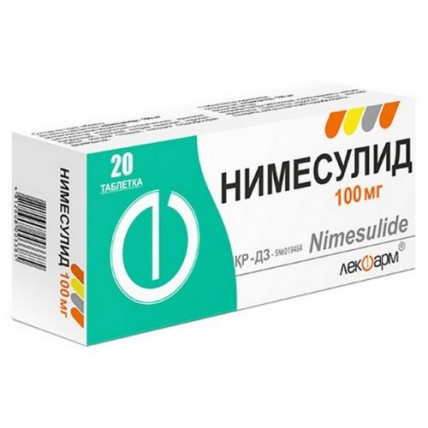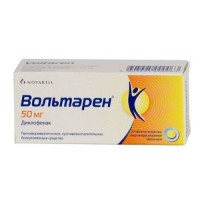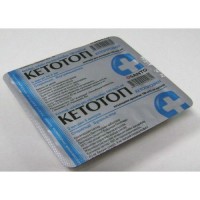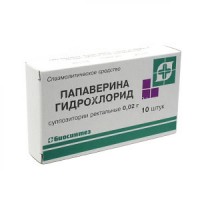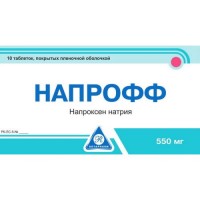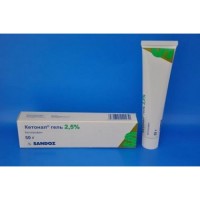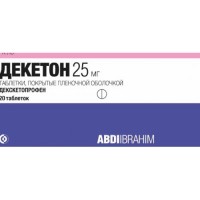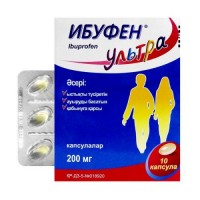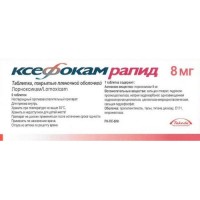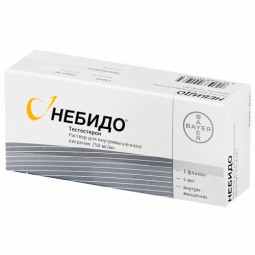Nimesulide 100mg (20 tablets)
- $4.60
Out Of Stock
The instruction for medical use of NIMESULIDE medicine the Trade name Nimesulide the International unlicensed name Nimesulide Dosage Form of the Tablet, 100 mg Structure One tablet contains active agent - Nimesulide of 100 mg, excipients: microcrystalline cellulose, corn starch, sodium krakhmalglikolit (type A), silicon dioxide colloidal anhydrous, talc, magnesium stearate, calcium hydrophosphate a dihydrate. The description Round tablets of light yellow color, with a smooth biconvex surface. Pharmacotherapeutic group Drugs for treatment of diseases of a musculoskeletal system. Anti-inflammatory and antirheumatic drugs. Nonsteroid antirheumatic drugs. Other non-steroidal anti-inflammatory drugs. Nimesulide. The ATX M01AX17 code the Pharmacological Pharmacokinetics At properties intake Nimesulide is very quickly and almost completely absorbed, and this process does not depend on meal. At reception of 100 mg the maximum concentration of drug 2.86 – 6.50 mg/l are reached in 1.22 - 2.75 hours. It is necessary to tell that in 30 minutes after oral administration the concentration of drug in plasma makes more than 50% of maximum. Elimination half-life of Nimesulide fluctuates in the range of 1.8 - 4.7 hours. Nimesulide elimination mainly happens by metabolic transformation. The main metabolite is the 4th '-hydroxy-Nimesulide which maximum concentration is reached on 1 – 3 hour after Nimesulide. The 4th '-hydroxy-Nimesulide is clinically active metabolite and is of great importance as drug is exposed to enterogepatichesky circulation. Removal of Nimesulide happens as to urine (65%), and to a stake (35%). About 98% of the accepted dose are removed within 24 hours. At long therapy of accumulation of medicine it is not observed. The pharmacodynamics Nimesulide is non-steroidal anti-inflammatory drug (NPVS) from a class of sulfonanilid. Has the anti-inflammatory, anesthetizing and febrifugal effect which mechanism is caused by selection inhibition of cyclooxygenase-2 that leads to suppression of biosynthesis of prostaglandins in the inflammation center. Drug in therapeutic doses has no negative impact on synthesis of prostaglandins in digestive tract and kidneys that causes good tolerance of Nimesulide. Also, therapeutic effect of Nimesulide is caused by its impact on some other factors: suppression of a factor of activation of thrombocytes, factor of necrosis of tumors alpha, suppression of proteinases and histamine, etc. Indications - treatment of acute pains - symptomatic treatment of an osteoarthritis with a pain syndrome - treatment of primary dysmenorrhea. Nimesulide it is necessary to appoint a route of administration and doses only as drug of the second line. The decision on therapy has to be made by Nimesulide on the basis of assessment of all risks for the specific patient. The drug is taken on 100 mg (1 tablet) by 2 times a day after a meal. Tablets are washed down with enough water. The maximum daily dose – 200 mg. Dose adjustment of drug is not required from elderly people. The maximum duration of intake of Nimesulide should not exceed 5 days. Side effects the Frequency of cases is classified as follows: very often (≥1/10), it is frequent (≥1/100, & lt, 1/10), sometimes (≥1/1000, & lt, 1/100), is rare (≥1/10000, & lt, 1/1000), is very rare (& lt, 1/10000), including separate cases). Disturbances from blood and lymphatic systems: seldom – anemia, an eosinophilia, it is very rare – thrombocytopenia, a pancytopenia, a purpura. Disturbances from the immune system: seldom – hypersensitivity, it is very rare – an anaphylaxis. Disturbances from metabolism: seldom – a hyperpotassemia. Disturbances from mentality: seldom – sensation of fear, nervousness, dreadful dreams. Disturbances from the central nervous system: sometimes – dizziness, is very rare – a headache, drowsiness, encephalopathy (a syndrome to Reja). Disturbances from an organ of sight: seldom – the indistinct sight, is very rare – a visual disturbance. Disturbances from an organ of hearing: very seldom – vertigo. Disturbances from heart: seldom – tachycardia. Disturbances from vessels: sometimes – arterial hypertension, it is rare – a hemorrhage, lability of arterial blood pressure, 'inflows'. Disturbances from the respiratory system, bodies of a thorax and mediastinum: sometimes – an asthma, it is very rare – asthma, a bronchospasm. Disturbances from digestive tract: often – diarrhea, nausea, vomiting, sometimes – a constipation, a meteorism, gastritis, it is very rare – an abdominal pain, dyspepsia, stomatitis, a tar-like chair, gastrointestinal bleeding, an ulcer and perforation of a 12-perstny gut, an ulcer and perforation of a stomach. Disturbances from a liver and biliary tract: often – increase in level of liver enzymes, is very rare – hepatitis, lightning hepatitis (including lethal outcomes), jaundice, a cholestasia. Disturbances from skin and hypodermic cellulose: sometimes – an itching, rash, the increased perspiration, it is rare – an erythema, dermatitis, is very rare – urticaria, a Quincke's disease, a face edema, an erythema poliformny, Stephens-Johnson's syndrome, a toxic epidermal necrolysis. Disturbances from kidneys and urinary tract: seldom – a dysuria, a hamaturia, an urination delay, it is very rare – a renal failure, an oliguria, interstitial nephrite. The general disturbances and reactions in the injection site: sometimes – hypostasis, it is rare – weakness, an asthenia, is very rare – a hypothermia. Contraindications - hypersensitivity to Nimesulide or to one of drug excipients - the giperergichesky reactions taking place in the past (for example a bronchospasm, rhinitis, a small tortoiseshell) in connection with intake of acetylsalicylic acid or other non-steroidal anti-inflammatory drugs - hepatotoxic reactions to Nimesulide in the anamnesis - the accompanying intake of other substances with potential hepatotoxicity - alcoholism, drug addiction - ulcer of stomach or duodenum in an aggravation phase, in the anamnesis of an ulcer, perforation or bleeding in digestive tract - in the anamnesis cerebrovascular bleedings or other hemorrhages and also the diseases which are followed by bleeding - heavy disturbances of fibrillation - heavy heart failure - a heavy renal failure (clearance of creatinine & lt, 30 ml/min.) - a liver failure - patients with symptoms of cold or flu - children's age up to 18 years - pregnancy and the period of a lactation - hereditary intolerance of fructose, glucose galactose malabsorption, insufficiency of invertase-isomaltase - diseases of a liver and increase in liver enzymes Medicinal interactions the Concomitant use of Nimesulide with corticosteroids, antithrombocytic means and selective serotonin reuptake inhibitors (SSRIs) increases risk of developing of a gastrointestinal ulcer or bleeding. The patients applying warfarin or similar anticoagulants and also acetylsalicylic acid at simultaneous use with Nimesulide, have an increased risk of developing of bleedings. Therefore such combination is not recommended, and at severe forms of disturbance of blood clotting it is contraindicated. If such combination cannot be avoided, then regular control of a condition of a coagulant system of blood is necessary. Nimesulide can reduce effect of diuretics and other antihypertensive drugs. Some patients with a renal failure at joint appointment have Nimesulide and APF inhibitors, the antagonists of angiotensin II or substances suppressing the system of cyclooxygenase, perhaps further deterioration in function of kidneys and developing of an acute renal failure which, as a rule, is reversible. Therefore it is necessary to appoint joint intake of these drugs with care, especially for elderly patients. Patients have to receive enough liquid, and renal function should be controlled carefully after the beginning of combination therapy. At healthy volunteers Nimesulide can temporarily reduce diuretic effect of furosemide and removal of sodium, smaller degree - potassium therefore at simultaneous use of Nimesulide and furosemide the patients with a renal failure or hearts should observe extra care. Joint intake of Nimesulide and furosemide concentration - time' (AUC) and decrease in cumulative excretion of furosemide without change of renal clearance of furosemide leads to reduction (approximately for 20%) the areas under a curve '. Nimesulide can reduce clearance of lithium that leads to increase in level of lithium in blood plasma and its toxicity. When prescribing Nimesulide the patients receiving therapy by lithium drugs should exercise frequent control of level of lithium in plasma. At simultaneous use with glibenclamide, theophylline, warfarin, digoxin, Cimetidinum and antiacid drugs of clinically significant interactions it is noted. Nimesulide suppresses activity of CYP2C9 enzyme. At a concomitant use with Nimesulide of the drugs which are substrates of this enzyme, concentration of these drugs in plasma can increase. When prescribing Nimesulide less than in 24 hours prior to or less than in 24 hours after reception of a methotrexate, it is required to be careful as in such cases methotrexate level in plasma and, respectively, toxic effects of this drug can increase. At simultaneous use with cyclosporine the increase in nephrotoxicity of the last is possible. The researches in vitro showed that Nimesulide is forced out from places of binding by tolbutamide, salicylic acid and valproic acid. In spite of the fact that these interactions were defined in blood plasma, the specified effects were not observed in the course of clinical use of drug. During treatment by Nimesulide it is necessary to avoid simultaneous use with the drugs having hepatotoxic effect and also alcohol abuses as these substances can increase risk of emergence of side reactions from a liver. Special instructions Undesirable side effects can be minimized, using the smallest effective dose with the smallest duration necessary for control of symptoms of a disease. In the absence of improvement of symptomatology the therapy by drug should be cancelled. At fervescence and emergence of grippopodobny symptoms in the patients applying Nimesulide, administration of drug should be cancelled. It is reported about exceptional cases of serious reactions from a liver, including, about very exceptional cases of a lethal outcome connected with use of nimesulidsoderzhashchy medicines. The patients feeling the symptoms similar to symptoms of damage of a liver (for example, anorexia, nausea, vomiting, an abdominal pain, fatigue, dark color of urine) during the Nimesulide drug treatment or patients at whom data of laboratory analyses of function of a liver deviate from normal values have to cancel drug treatment. Repeated prescribing of Nimesulide is contraindicated to such patients. It is reported about damage of a liver, in most cases reversible, after short-term influence of drug. During treatment by Nimesulide it is necessary to abstain from intake of other analgetics. It is necessary to avoid the accompanying use of Nimesulide and other NPVP, including, selection inhibitors of cyclooxygenase-2. At patients of advanced age the frequency of adverse reactions to non-steroidal anti-inflammatory drugs, especially, the frequency of gastrointestinal bleedings and a perforation is increased that can be deadly to the patient. Gastrointestinal bleeding, an ulcer and a perforation of the ulcer can threaten the patient's life if in medical history there are records about emergence of similar problems at intake of any non-steroidal anti-inflammatory drugs during treatment (without limitation period), with existence or without existence of dangerous symptoms, or existence in the anamnesis of serious violations of digestive tract. The risk of developing of gastrointestinal bleeding, ulcer or perforation of the ulcer increases with increase in a dose of non-steroidal anti-inflammatory drug at patients with presence of the ulcer in the anamnesis which is, especially, complicated by hemorrhage or a perforation and also at elderly patients. For these patients the treatment should be begun with the smallest possible dose. For these patients and also patients who accept at the same time low doses of aspirin or other drugs increasing risk of developing of a gastrointestinal disease it is necessary to consider the possibility of use of combination therapy using the means protecting mucous a stomach (for example, a misoprostol or inhibitors of the proton pump). Patients with a toxic gastrointestinal tract disease, especially, elderly, have to report about any unusual symptoms arising in digestive tract (especially, about gastrointestinal bleedings). It is especially important at the initial stages of treatment. The patients taking the accompanying drugs which can increase risk of developing of an ulcer or bleeding, for example, oral corticosteroids, anticoagulants, such as warfarin, selection inhibitors of repeated absorption of serotonin or antithrombocytic means, such as aspirin have to be informed on need of respect for care at administration of drug. In case of emergence at the patients receiving the drug Nimesulide, gastrointestinal bleeding or an ulcer, drug treatment should be cancelled. Patients should appoint Nimesulide with care with gastrointestinal diseases in the anamnesis (ulcer colitis, Crohn's disease) as exacerbation of these diseases is possible. Patients with hypertensia and/or a weak/moderate acute heart failure in the anamnesis and also to patients with emergence of a delay of liquid in an organism and hypostases as reactions to therapy use by non-steroidal anti-inflammatory drugs, need the corresponding control of a state and consultation of the doctor. Clinical trials and epidemiological data allow to draw a conclusion that some non-steroidal anti-inflammatory drugs, especially, in high doses and at prolonged use, can result in insignificant risk of emergence of arterial trombotichesky events (for example, a myocardial infarction or a stroke). For an exception of risk of emergence of such events at use of Nimesulide of data it is not enough. To patients with uncontrollable hypertensia, an acute heart failure, coronary heart disease, a disease of peripheral arteries and/or a cerebrovascular disease and also at patients with risk factors of developing a cardiovascular disease (for example, in a hypertension, a lipidemia, diabetes, when smoking) it is necessary to appoint Nimesulide after careful assessment of a state. At patients with renal or heart failure Nimesulide should be applied with care as drug can worsen function of kidneys. In case of aggravation of symptoms the treatment should be cancelled. Elderly patients are especially subject to adverse reactions to NPVP, including developing of gastrointestinal bleedings and perforation, deterioration in function of kidneys, liver and heart. Therefore appropriate clinical control is reasonable. As Nimesulide can influence function of thrombocytes, patients should appoint it with care with hemorrhagic diathesis. However, Nimesulide does not replace acetylsalicylic acid at prevention of cardiovascular diseases. There are data on very exceptional cases of serious skin reactions to non-steroidal anti-inflammatory drugs some of which can be deadly, including exfoliative dermatitis, Stephens-Johnson's syndrome and toxic epidermal necrosis. Patients have very high risk of such reactions if at earlier appointed course of treatment the reaction approach in most cases arose within the first month of treatment. Nimesulide should be cancelled at the first symptoms of skin rash, damage of mucous membranes and other signs of allergic reaction. Features of influence of medicine on ability to run vehicles or potentially dangerous mechanisms With care are appointed to patients whose work is connected with need of special attention and soon
ti. Overdose Symptoms: apathy, nausea, vomiting, drowsiness, headache, increase in the ABP, renal failure, respiratory depression, spasms, liver failure. Treatment: washing of digestive tract, intake of activated carbon, infusional therapy, symptomatic therapy. There is no specific antidote. A form of release and packing On 10 tablets in blister strip packaging from a film of polyvinylchloride and aluminum foil. One or two blister strip packagings together with the instruction for medical use in the state and Russian languages are placed in a pack from cardboard. To Store storage conditions in the place protected from moisture and light at a temperature not above 25 °C. To store out of children's reach! Period of storage 3 years. Not to apply after an expiration date. Prescription status According to the prescription Producer SOOO "Lekfarm", Republic of Belarus, 223141, Logoysk, Minskaya St., 2a Ph./fax: (01774)-53801 e-mail: office@lekpharm.by Owner of the registration certificate of SOOO "Lekfarm", Republic of Belarus, 223141, Logoysk, Minskaya St., 2a Ph./fax: (01774)-53801, e-mail: office@lekpharm.by the Name, the address and a contact information (phone, the fax, e-mail) of the organization in the territory of the Republic of Kazakhstan, the accepting claim (offer) on quality of medicine from consumers, responsible for post-registration observation of safety of medicine Representative office of SOOO "Lekfarm" in Republic of Kazakhstan, 050000, Almaty, Bostandyksky district, Al-Farabi Avenue 7, BC Nrly Tau, body 4a, office 55, ph. 8 (727)-3110454, fax 8 (727)-3110455, e-mail:
To Develop amangul-62@mail.ru
ti. Overdose Symptoms: apathy, nausea, vomiting, drowsiness, headache, increase in the ABP, renal failure, respiratory depression, spasms, liver failure. Treatment: washing of digestive tract, intake of activated carbon, infusional therapy, symptomatic therapy. There is no specific antidote. A form of release and packing On 10 tablets in blister strip packaging from a film of polyvinylchloride and aluminum foil. One or two blister strip packagings together with the instruction for medical use in the state and Russian languages are placed in a pack from cardboard. To Store storage conditions in the place protected from moisture and light at a temperature not above 25 °C. To store out of children's reach! Period of storage 3 years. Not to apply after an expiration date. Prescription status According to the prescription Producer SOOO "Lekfarm", Republic of Belarus, 223141, Logoysk, Minskaya St., 2a Ph./fax: (01774)-53801 e-mail: office@lekpharm.by Owner of the registration certificate of SOOO "Lekfarm", Republic of Belarus, 223141, Logoysk, Minskaya St., 2a Ph./fax: (01774)-53801, e-mail: office@lekpharm.by the Name, the address and a contact information (phone, the fax, e-mail) of the organization in the territory of the Republic of Kazakhstan, the accepting claim (offer) on quality of medicine from consumers, responsible for post-registration observation of safety of medicine Representative office of SOOO "Lekfarm" in Republic of Kazakhstan, 050000, Almaty, Bostandyksky district, Al-Farabi Avenue 7, BC Nrly Tau, body 4a, office 55, ph. 8 (727)-3110454, fax 8 (727)-3110455, e-mail:
To Develop amangul-62@mail.ru
